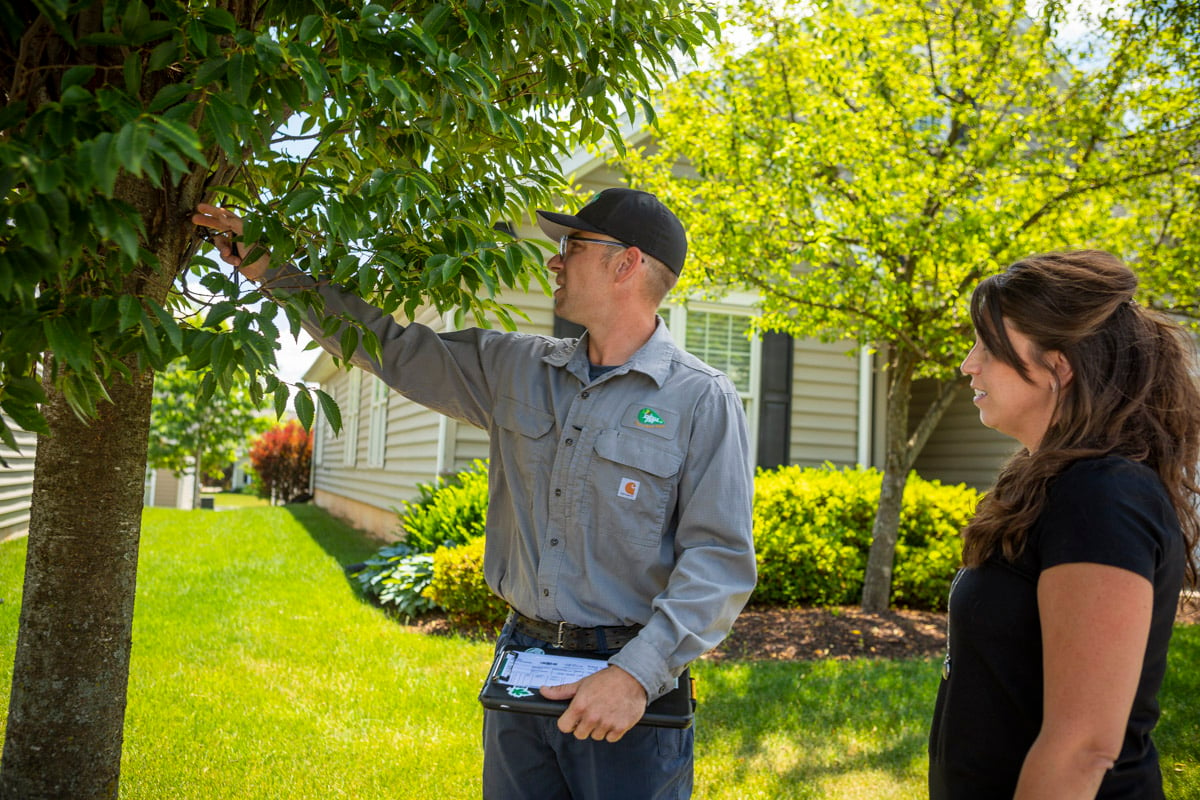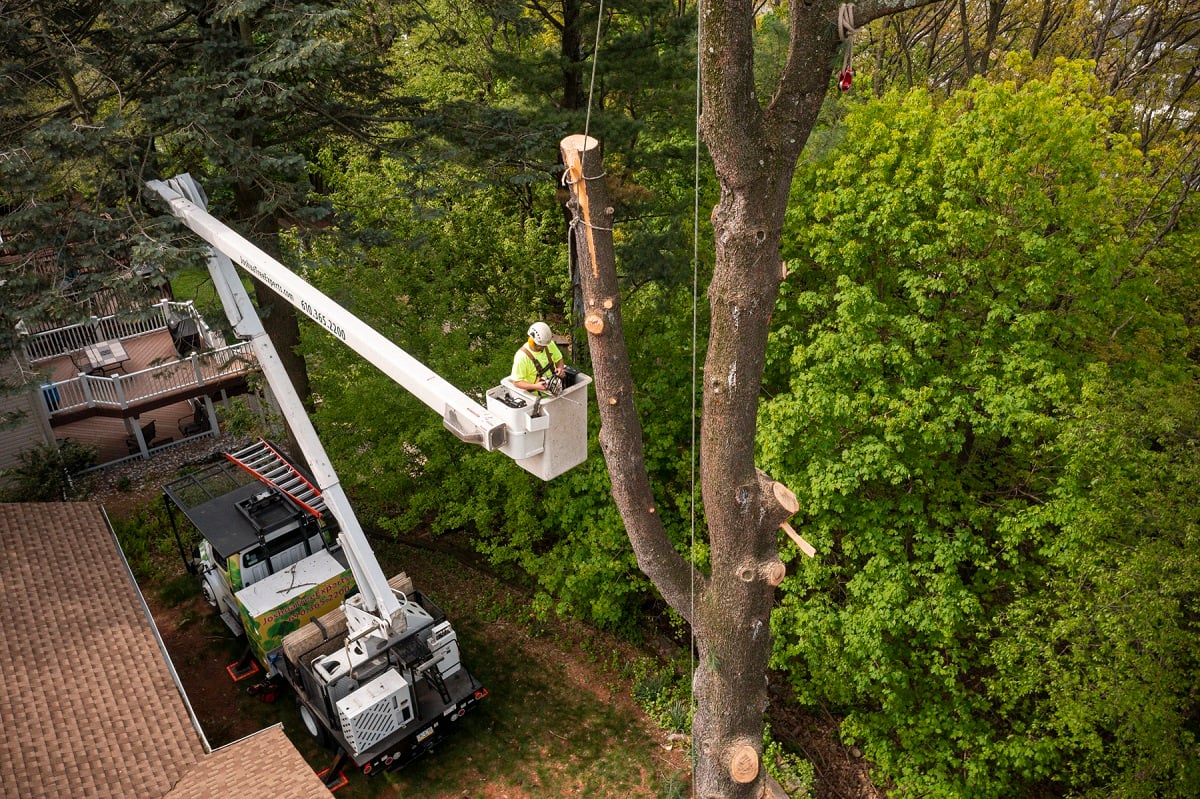Over the years as tree care experts we have had many clients and potential clients tell us that they suspect their tree is dead. So often, homeowners see their tree struggling in some way and assume it’s dead or dying.
Fortunately, more times than not, the tree is not actually dead—but it could be on its way there. That’s why we’ve rounded up some advice on how to tell if a tree is dead.
We understand that your trees are an important part of your landscape and you want to do what you can to protect them.
How to Tell if a Tree is Dead
Here’s the simplest way to tell if your tree is dead or not. If a tree still has leaves on it, then it is not dead. Oftentimes when homeowners tell us they think they have dead trees, those trees are still bearing leaves.
Still, that’s not to say that their tree isn’t very sick. Oftentimes when homeowners notice what they suspect is something wrong with their tree, they are onto something. Any change in your tree is worth pointing out to a professional.

Sometimes these trees can be extremely stressed, diseased, or infested with insects, or if it’s a period of drought, they might have even gone into dormancy.
Since a tree may not be completely dead yet but could be declining, let’s look into some dying tree symptoms. A tree that is declining but not fully dead may still be able to be saved but it’s important that you take action swiftly.
Dying Tree Symptoms to Look For
There are a few symptoms that should give you a good idea of whether your tree is dying (or at least very sick). Here are several that we would suggest looking for.
Bark Peeling Off
When the bark is peeling off or there are a lot of cracks in the trunk, then your tree is in a state of decline. As you may know, the bark is the protective layer of the tree and is very important to its health.
Trees that are dying may shed their bark, leaving them exposed to more problems. Peeling bark can also mean that the tree needs more nutrients. So, even if it’s not currently dying, it could be soon.
Branches Falling
Another symptom to watch for is falling branches. Dying trees tend to drop branches more often than healthy trees. Oftentimes, as a tree declines, it begins to dry out and rot. This can make branches weak.
Animals Nesting
Sometimes, animals nesting in the tree can be a symptom of a problem. Woodpeckers prefer dead wood as the rotting hardwood makes it easier for them to create their nest cavities. If you suddenly notice that you have a woodpecker taking up residence, it could be that your tree is declining.
Other animals like bats and squirrels will also make or use cavities in trees for homes.
The Appearance Mushrooms and Other Fungi
Dying tree symptoms might also include the appearance of mushrooms and other fungi. Mushrooms love dead wood. If you suddenly see big patches of mushrooms surrounding your tree, it could indicate that they are eating the dead roots.
Can a Half-Dead Tree be Saved?
This is a question that we often receive during a tree inspection. If a tree is exhibiting one or more of the symptoms above and we let homeowners know that their tree is actively declining, they want to know whether it can still be saved.
The answer is, it depends.

Some of the major factors that will contribute to whether a half-dad tree can be saved are the species and the location. Some trees can bounce back, even when all of the dead wood is removed.
But you also have to consider the aesthetics. If you were to have 50 percent of that tree removed (all of the dead wood), is it going to become a huge eyesore?
The answer is probably yes. But some homeowners are willing to live with that if it’s a tree that they love and we feel it can be safely pruned and eventually restored to good health.

However, it’s also important to consider that removing half of a dead tree might make it unbalanced and unsafe to leave on the property. If it’s a matter of safety, it might be in your best interest to have that tree removed.
Tree removal can be performed year-round, though we’ve written an article on some of the reasons why it’s a service that might want to be considered in the winter. The main reason is that tree removal is easier when trees are dormant.
While it’s always sad to see a tree go, when safety is a concern, it’s always best to be cautious. Sometimes, if the problem is an insect or a disease, and it’s been ravaged by one or both, it can be difficult to stop that from getting worse.
Rather than fighting an uphill battle that may never be won, removal might be your best course of action.
Working with a Tree Care Professional
At the end of the day, we don’t expect you to know everything about how to tell if a tree is dead. That’s why it is so beneficial to work with a professional you can trust.
A tree care expert can perform an assessment and let you know what is going on with your tree. They’ll also be able to give you a better answer to your question of can a half-dead tree be saved?
When they’re looking at your specific tree and what it’s dealing with, a tree care professional will be able to devise the best possible solution for your property.
With the right care for your trees, you’ll gain valuable peace of mind. If you’re interested in having your trees inspected and their health assured, contact us for a free consultation or give us a call at 833-JTE-TREE.




